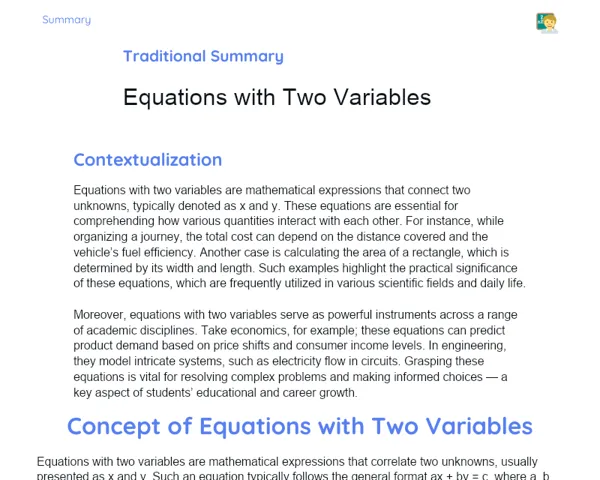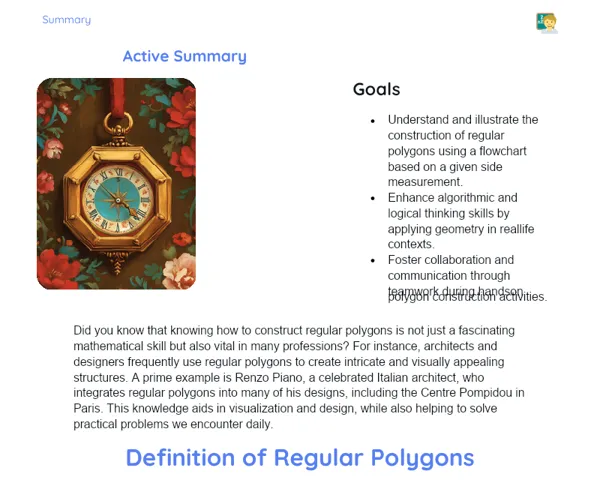Goals
1. Review the values of sine, cosine, and tangent for the angles of 30º, 45º, and 60º.
2. Use trigonometry to find the lengths of the sides of right triangles that have these angles.
Contextualization
Trigonometry is a vital aspect of mathematics that we encounter regularly in our day-to-day activities. Whether it’s in building construction or developing computer games, grasping the concepts of sine, cosine, and tangent is crucial for solving real-world problems in fields like engineering, architecture, and even physics. These principles help us accurately measure distances, heights, and angles, which are fundamental for creating safe and functional buildings. For instance, civil engineers rely on trigonometry to correctly slope ramps in public spaces, while game developers use these concepts to design realistic movements in 3D environments.
Subject Relevance
To Remember!
Basic Trigonometric Values
The sine, cosine, and tangent values for angles of 30º, 45º, and 60º are key in trigonometry. These values are frequently used in calculations involving right triangles and have practical applications in disciplines such as engineering, architecture, and physics.
-
Sine of 30º: 1/2
-
Cosine of 30º: √3/2
-
Tangent of 30º: √3/3
-
Sine of 45º: √2/2
-
Cosine of 45º: √2/2
-
Tangent of 45º: 1
-
Sine of 60º: √3/2
-
Cosine of 60º: 1/2
-
Tangent of 60º: √3
Calculating the Sides of Right Triangles
With the trigonometric values of sine, cosine, and tangent, you can determine the lengths of the sides of right triangles. This skill is particularly handy in fields like engineering and architecture, where accurate measurements are paramount.
-
The hypotenuse is the longest side, opposite the right angle.
-
The legs are the sides that form the right angle.
-
The sine formula helps find the length of the side opposite an angle.
-
The cosine formula assists in determining the length of the side adjacent to an angle.
-
The tangent formula gives the ratio of the opposite leg to the adjacent leg.
Practical Applications of Trigonometry
Trigonometry sees widespread application across various professional fields. In construction, aviation, and video game design, trigonometric principles are integrated to resolve intricate problems and guarantee precision and safety.
-
Civil engineering: calculating slopes and heights of structures.
-
Aviation: determining flight paths and altitudes.
-
Video game design: enabling realistic movements and three-dimensional environments.
Practical Applications
-
In construction, engineers apply trigonometry to estimate the heights of buildings and the steepness of ramps.
-
In aviation, pilots and air traffic controllers use trigonometry to chart flight paths and altitudes, ensuring safe operations.
-
In video game design, trigonometry plays a critical role in crafting lifelike movements and simulating 3D environments.
Key Terms
-
Sine: the ratio of the opposite leg to the hypotenuse in a right triangle.
-
Cosine: the ratio of the adjacent leg to the hypotenuse in a right triangle.
-
Tangent: the ratio of the opposite leg to the adjacent leg of a right triangle.
-
Hypotenuse: the longest side of a right triangle, found opposite the right angle.
-
Leg: each of the two shorter sides of a right triangle adjacent to the right angle.
Questions for Reflections
-
How can trigonometry shape the safety and accuracy of architectural designs?
-
In what other areas outside engineering and architecture are sine, cosine, and tangent utilized?
-
Why is it vital to have a solid grasp of fundamental trigonometric values for solving everyday problems?
Practical Challenge: Measuring the Height of an Object
Utilise your newfound knowledge of trigonometry to measure the height of a tall object at your home or school, such as a tree or a building.
Instructions
-
Select a tall object you wish to measure.
-
Position yourself at a known distance from the object.
-
Using a protractor, a weight on a string (like a nut), and a straw, construct a simple theodolite.
-
Look through the straw, align it with the top of the object, and note the angle created by the plumb line on the protractor.
-
Employ the tangent formula (tan(θ) = height/distance) to compute the height of the object.
-
Verify your calculations and, if possible, compare your estimated height with the actual height.



